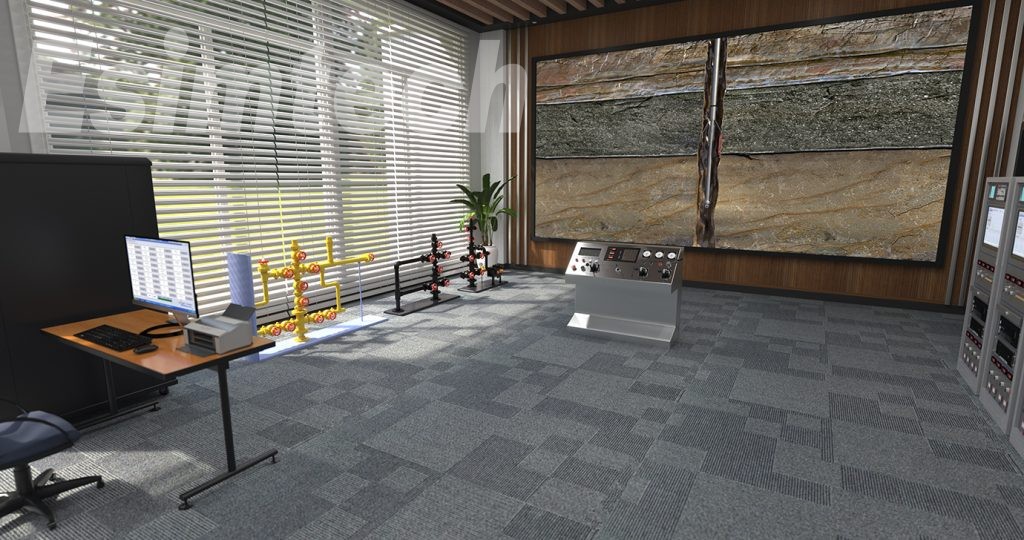An uncased or open hole section of a wellbore is referred to as an open hole section. An open hole well logging simulator is a digital tool that simulates the process of carrying out well logging measurements in such a section of a wellbore. There is no casing surrounding this portion of the wellbore that you can see here. With the assistance of this simulator, users are able to experience and learn about the well logging techniques used in the oil and gas industry. This simulator removes the need for users to have physical wells or actual equipment in order to participate in the simulation.
The following are essential elements that make up an open-hole well logging simulator:
1. Virtual Environment: The simulator will produce a digital image of a wellbore for its virtual environment, and this image will show that there is a section of the well that is open
2. Users are able to interact with this environment and carry out a variety of well logging measurements just as if they were performing these tasks in an actual well
3. This environment simulates a real-world setting as closely as possible
Instruments used for measuringThe logging tools that are typically carried out in the field are modeled in the simulator through the use of digital representations of those tools. The functionality of real logging tools, such as gamma ray detectors, resistivity probes, density sensors, and many others, is simulated by these tools. These tools include a wide variety of logging tools.
The Gathering of Accurate InformationThe interactions that take place between the virtual tools and the virtual formations are what the simulator uses to generate the data that is simulated. This makes it possible to generate data that is accurate to the situation. Users are in a position to interpret and evaluate the results because the data reflect the responses that are anticipated from the various types of rock and fluid content. This enables users to interpret and evaluate the results.
Interaction with the Person Using the SystemAfter that, the simulator will respond with data as well as graphical representations of the qualities possessed by the formation.
Open Hole Well Logging Simulators are frequently utilized for the purposes of education and training. In a setting that does not put them in any danger, students, professionals, and enthusiasts alike can get hands-on experience with well logging techniques, improve their ability to interpret results, and develop a deeper comprehension of the subsurface formations. These types of settings offer this particular service.
The use of an ESIM-FWL3 open hole well logging simulator comes with a number of benefits, some of which are as follows:
Learning by Doing: The simulator gives users the opportunity to participate in learning by doing by allowing them to engage with ESIM-FWL3 open hole well logging simulator and techniques within a digital environment. This gives users the opportunity to participate in hands-on learning.
Users are able to train without the dangers that are present during actual well logging operations. These dangers include the possibility of damaging equipment or incorrectly interpreting data. Users are able to practice without these risks being an issue.
Because the simulator provides users with immediate feedback based on their interactions with the software, users are able to learn how various formations and fluids affect measurement responses through the use of the simulator's interactive feedback. This allows users to gain a better understanding of how measurement responses are affected.
Multiple Scenarios: Users have the ability to simulate multiple scenarios by modifying tool types, positioning, and formations in order to gain insights into the ways in which these variables influence measurement outcomes. This feature allows users to better understand how different tool types, positioning, and formations influence measurement outcomes.
The Use of Physical Wells, Tools, and Field Operations Can Be Reduced When Training Is Carried Out on a SimulatorBecause of this, educational programs no longer require the use of physical wells, tools, or field operations, which results in cost savings for those programs.
The user's theoretical knowledge is improved by the simulator because it gives them the opportunity to practically apply the concepts that they have learned in well logging classes. This helps the user to better understand how the concepts relate to real-world situations.
Customers Who Might Have an Interest:
Students: Students who are working toward degrees in geology, petroleum engineering, or other fields that are related can use the simulator to supplement the knowledge they gain in the classroom. This includes students who are working toward degrees in other fields that are also related.
Industry Professionals Working in the Oil and Gas SectorThose who work in the oil and gas industry can use the simulator to hone their skills, get acquainted with new tools, or gain knowledge about logging procedures that are foreign to them.
Educational Establishments and Vocational Instruction Centers:It is possible for educational institutions and training centers to use these simulators in order to provide students with training opportunities that are both realistic and practical.
An Open Hole Well Logging Simulator is a priceless piece of equipment that, to summarize, helps bridge the gap between theoretical knowledge and practical experience in the field of well logging. It provides a setting for learning and the development of skills that is risk-free, interactive, and immersive. Additionally, it contributes to a comprehensive understanding of the procedures that are essential to the oil and gas industry.
